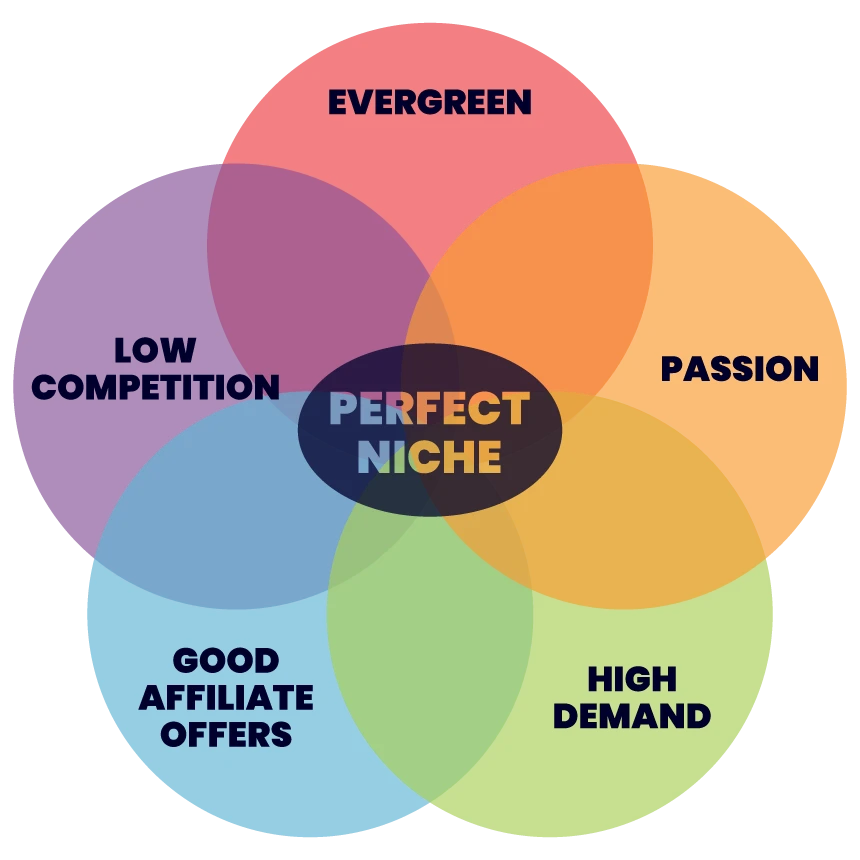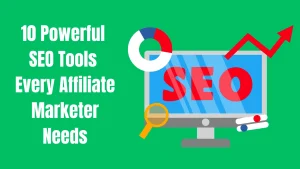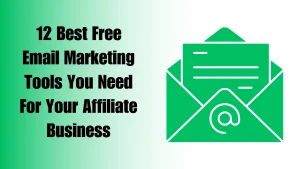10 Proven Affiliate Marketing Strategies for Beginners That Actually Work

Affiliate marketing seems simple. You recommend a product, someone buys through your link, and you earn a commission. No need to create your own product or handle customer service. Just drive traffic and get paid.
But most beginners struggle. They pick random products, post links everywhere, and expect quick money. When nothing happens, they assume affiliate marketing doesn’t work. The truth? It does work, but only with the right affiliate marketing strategies.
Another issue is relying on outdated methods. What worked years ago won’t always work now. In the recent era, competition is stronger, and buyers are smarter. People don’t just click links—they want trust, value, and real recommendations before making a purchase.
That’s why using the right affiliate marketing strategies is key. With a solid plan, even a small website can turn into a steady income stream. It’s all about great content, smart SEO, and building an audience that actually listens to you. Get those right, and success becomes a whole lot easier.
Key Takeaways: Best Affiliate Marketing Strategies for Beginners
- Pick a niche that interests you and has profit potential.
- Focus on a specific audience instead of trying to reach everyone.
- Create valuable content like reviews, guides, and comparisons.
- Use affiliate marketing strategies that drive free organic traffic.
- Choose reliable affiliate programs with good commission rates.
- Build an email list to keep your audience engaged.
- Use SEO to rank your content higher on search engines.
- Promote through social media, YouTube, and other channels.
- Optimize your website for better conversions and more clicks.
- Stay patient, track results, and adjust your approach over time.
10 Best Affiliate Marketing Strategies for Beginners
Without wasting much time, let’s dive in…
1. Choose the Right Niche
Picking the right niche is the foundation of your entire affiliate business. Get this wrong, and everything else becomes an uphill battle. The best niche isn’t just about what’s trending. It’s about what you can stick with and what people are actually searching for.
Some people chase high-paying commissions and burn out fast. Others pick something they love but realize no one else cares. You need a balance. Your niche should have demand, low competition, and long-term earning potential.
Recommended reading: 10 Best Niches for Affiliate Marketing in 2025
How to Find a Profitable Niche
Start with what you know or enjoy, but don’t stop there. Passion helps, but it won’t pay the bills if no one else is interested.
Use Google Trends, keyword research tools, and affiliate networks to see what’s selling. If a niche has active buyers, strong affiliate programs, and room for new voices, you’re on the right track.
Look at existing sites in your niche. Are they dominating search results, or do you see gaps you can fill? If you find a space where you can offer better content, deeper insights, or a unique perspective, that’s gold.
Key Factors to Consider
- Passion vs. Profit: A niche you enjoy makes content creation easier, but it also needs to make money.
- Competition Level: Some competition is good—it means the niche is profitable. Too much, and ranking will be tough.
- Affiliate Opportunities: Check if there are quality products with good commissions and reliable payouts.
- Evergreen Potential: Avoid trends that fade fast. Pick something with long-term demand so your content stays relevant.

The right niche won’t guarantee success, but the wrong one will almost always lead to failure. Choose wisely, and everything else becomes easier.
2. Focus on a Specific Audience
Trying to appeal to everyone is a mistake. A broad audience might sound good, but it’s hard to connect with people when your content is all over the place. The best way to make sales and build trust is to focus on a specific group and create content that speaks directly to them.
Think about it this way, would you rather buy from a general site that covers everything or from one that clearly understands your needs? People want recommendations from someone who “gets” them, not a site trying to sell to everyone.
How to Create Content That Speaks to Your Audience
Start by figuring out who you’re talking to. What are their biggest struggles? What questions do they keep asking? Your content should feel like a helpful conversation, not just another sales pitch.
Use the same language your audience does. If you’re in fitness, don’t just say, “This protein powder has 30g of protein.” Instead, say, “If you struggle to hit your protein goals, this shake makes it easy.” Make it about them, not just the product.
Examples of Niche-Specific Affiliate Sites
- HeadphonesAddict (audio gear): Targets people looking for the best headphones for specific needs.
- Minimalist Baker (simple recipes): Focuses on people who want easy, plant-based meals.
- SafeWise (home security): Helps homeowners find the best security systems.
Continue reading… 10 Best Affiliate Marketing Website Examples to Inspire Your Success
Each of these sites knows its audience and delivers exactly what they need. That’s the key. Define your audience, speak their language, and build trust. When they feel like your content is made just for them, conversions come naturally.
3. Build a Content-Driven Website
If you want to make real money with affiliate marketing, your website needs to offer value first. People don’t visit your site to get sold to—they come looking for answers, solutions, and honest recommendations. If your content delivers, they’ll trust you enough to click those affiliate links.

A content-driven site builds credibility and attracts consistent traffic. Without great content, you’re just another site pushing products with no real reason for people to stick around. The key is to create useful, engaging, and well-structured content that keeps visitors coming back.
Recommended reading: Why Valuable Content Wins in Affiliate Marketing (And How to Create It)
The Best Types of Content for Affiliate Marketing
Certain types of content naturally drive more traffic and sales. Here’s what works best:
- Reviews – In-depth breakdowns of products, covering both pros and cons. Readers want honest opinions before they buy.
- Comparisons – Side-by-side comparisons help readers make quick decisions. Example: MacBook Air vs. Dell XPS: Which Is Better for Students?
- Guides & Tutorials – Step-by-step content that teaches something useful. Example: How to Start a YouTube Channel (Best Cameras & Gear).
A good mix of these keeps your site valuable and relevant, rather than just feeling like a list of affiliate links.
Create High-Quality, Evergreen, and Shareable Content
Not all content holds its value over time. To build long-term traffic, focus on high-quality, evergreen content—posts that stay relevant for years. Instead of Best Laptops in 2025, go with Best Laptops for Graphic Designers (Updated Yearly). With small updates, it keeps ranking and driving clicks.
Make your content easy to share by adding useful visuals, infographics, and clear takeaways. The more people share your content, the more traffic and backlinks you get—boosting both SEO and credibility.
Quality beats quantity every time. A single well-researched, engaging post can bring in more traffic than ten rushed ones. Put in the effort, and your site will stand out.
Check the video below for more content strategy:
Balancing SEO and User Experience
SEO helps people find your content, but real people need to enjoy reading it. That means:
- Use keywords naturally – Don’t stuff them everywhere. Just write like a human.
- Make it easy to read – Short paragraphs, subheadings, bullet points. Nobody likes giant walls of text.
- Be honest – If a product has downsides, mention them. Readers respect honesty, and it builds credibility.
A content-driven site isn’t just about ranking on Google—it’s about helping people first. Do that well, and the sales will follow.
4. Use SEO to Attract Free Traffic
Affiliate marketing without SEO is like opening a store in the middle of nowhere. You might have great products, but if no one finds you, it won’t matter.
SEO (Search Engine Optimization) helps bring in free, consistent traffic—people actively searching for what you offer. When done right, it can drive thousands of visitors to your site every month.
On-Page and Off-Page SEO Essentials
SEO has two key parts: on-page (what happens on your site) and off-page (how others interact with your site).
- On-Page SEO: Use the right keywords, write clear and useful content, and optimize your headings, URLs, and images. Every page should be easy to read and valuable to visitors.
- Off-Page SEO: This includes backlinks (other sites linking to yours), social shares, and brand mentions. The more trustworthy sites linking to you, the higher Google ranks your content.
A well-optimized page can bring in traffic for years. If you’re not using SEO, you’re leaving money on the table.
Find and Rank for Profitable Keywords
Keyword research is the foundation of good SEO. You need to target terms people are searching for—but not just any terms. Some keywords are too competitive, while others don’t bring in buyers.
Look for low-competition, high-intent keywords. These are phrases people type in when they’re ready to buy. For example, instead of targeting “best headphones,” go for “best noise-canceling headphones under $200.” It’s more specific, easier to rank for, and attracts people looking to purchase.
Free tools like Google’s Keyword Planner or Ubersuggest can help you find profitable keywords. Once you have them, place them naturally in your content, titles, and headings. But don’t overdo it—Google hates keyword stuffing.
SEO Takes Time, But It Pays Off
Unlike paid ads, SEO isn’t instant. It takes weeks or months to see results. But once your pages rank, they can bring in traffic for years without extra effort. That’s why affiliate marketers who focus on SEO have a massive advantage. It’s free, scalable, and builds long-term income.
Put in the work now, and your future self will thank you.
5. Choose the Right Affiliate Programs
Not all affiliate programs are worth your time. Some pay peanuts, some take forever to convert, and some just aren’t reliable. Picking the right ones can mean the difference between decent side income and life-changing earnings.
High-Ticket vs. Recurring Commissions
There are two main ways to earn: high-ticket commissions (big one-time payouts) and recurring commissions (smaller but ongoing payments).
- High-ticket programs pay hundreds or even thousands per sale. These are often found in industries like software, finance, and luxury products. They require fewer sales but can take longer to convert.
- Recurring commissions give you a cut of monthly payments. Think subscription-based services like web hosting or software tools. One sale can keep paying you for months—or years.
The best approach? Mix both. Recurring commissions build a steady base, while high-ticket sales bring in big wins.
How to Find and Evaluate the Best Programs
Look for programs that match your niche, have good commission rates, and actually convert. A few things to check:
- Reputation – Do people trust the brand? A bad reputation will kill conversions.
- Commission structure – Some pay a flat rate, others a percentage. Higher isn’t always better if the product is hard to sell.
- Cookie duration – Longer is better. A 30-day cookie means you still earn if someone buys weeks later.
- Support & resources – Good programs provide marketing materials, training, and dedicated affiliate managers.
Check affiliate networks like ShareASale, Impact, or CJ Affiliate. They list thousands of programs with reviews and earnings data.
Recommended reading: How to Choose the Best Affiliate Programs for More Earnings and Long-Term Growth
Red Flags to Watch Out For
Some programs look great at first but end up wasting your time. Here’s what to avoid:
- Low commissions – If you’re making $1 per sale, you’ll struggle to earn much.
- Short cookie windows – A 24-hour cookie gives you almost no chance of getting credit.
- Slow or missing payments – If affiliates are complaining about payouts, run.
- Unclear terms – Some programs have hidden rules that can cancel your commissions. Always read the fine print.
Picking the right programs takes time, but it’s worth it. A great affiliate program doesn’t just pay well—it makes selling easier. Choose wisely, and your earnings will thank you.
6. Build an Email List for Long-Term Success
Affiliate sales come and go, but an email list is yours forever. It’s the one thing you control, no matter what happens with Google rankings, social media, or ad costs. A strong list means you can make money on demand—whenever you hit send.

Recommended reading: How to Build a Strong Email List for Your Affiliate Marketing Business
Why Email Marketing Matters
People don’t always buy on the first visit. Maybe they’re not ready. Maybe they need more info. If you don’t grab their email, they’re gone.
With a list, you can stay in touch, build trust, and bring them back when they’re ready to buy. Email marketing lets you promote offers repeatedly without relying on random website traffic.
How to Collect Leads Without Being Pushy
People hate spam. They won’t give you their email unless there’s something in it for them. So, offer value.
A free guide, cheat sheet, or exclusive deal works well. Make sure it solves a problem your audience cares about. For example:
- A fitness site could offer a “7-Day Meal Plan for Fat Loss”
- A tech blog might give a “Best Budget Laptops Under $500” guide
- A finance site could share “5 Ways to Save Money Every Month”
Keep the signup process simple. Just an email box and a clear reason to subscribe. No long forms. No unnecessary questions.
Best Strategies to Nurture and Convert Subscribers
Once they’re on your list, don’t just spam them with links. Warm them up first. Send helpful content, quick wins, and personal insights. Show them you know your stuff.
Then, mix in promotions naturally. Recommend products when it makes sense. Share your experiences. People buy from those they trust.
Keep your emails short, conversational, and easy to read. Nobody wants to wade through a wall of text. Add some personality. Make it feel like a friend is writing, not a robot.
An email list is the closest thing to a guaranteed income in affiliate marketing. Start now, even if it’s small. Over time, it’ll be your biggest asset.
7. Use Social Media to Drive Traffic
Social media isn’t just for sharing memes and arguing about nonsense. If you use it right, it’s a goldmine for affiliate marketing. Platforms like YouTube, TikTok, and Pinterest can send thousands of visitors to your site—without paying a dime.

How Platforms Can Boost Affiliate Sales
Each platform works differently, but they all have one thing in common: attention. People scroll for hours. Your job is to grab their interest and send them where you want—your website, landing page, or affiliate link.
- YouTube is perfect for in-depth reviews, tutorials, and “best of” lists. People search for buying advice all the time.
- TikTok thrives on quick, engaging videos. Show products in action. Hook people fast. Make them curious.
- Pinterest works like a search engine. Create eye-catching pins that lead to your blog posts or product pages.
If you’re not using at least one of these, you’re leaving money on the table.
Organic vs. Paid Social Strategies
Organic traffic takes time but costs nothing. The key is consistency. Post regularly, use the right keywords (hashtags matter), and engage with your audience. Over time, your reach grows naturally.
Paid ads speed things up. You can target specific interests, locations, and behaviors. This works well if you have a proven offer, but it’s easy to burn cash if you don’t know what you’re doing. Test small before going all in.
Tips for Creating Engaging Social Content That Converts
Nobody cares about generic content. If you’re just reposting product images, you won’t get far. You need to stand out.
- Be authentic – Share personal experiences. Show the product in real use. People trust honesty.
- Hook fast – The first few seconds matter. Grab attention with a bold statement or intriguing question.
- Call to action – Tell people what to do next. “Click the link,” “Read the full review,” or “Check out the details below.”
Social media isn’t a magic bullet, but if you stay consistent and create content that actually helps people, it can become a major traffic source.
8. Optimize for Conversions
Getting traffic is great, but if no one clicks your links or buys, it’s pointless. You need to focus on conversions. That means crafting strong CTAs, designing effective landing pages, and constantly testing what works best.
The Power of Strong Call-to-Actions (CTAs)
People won’t take action unless you tell them what to do. A weak CTA like “Check it out” won’t cut it. You need clear, direct, and action-driven phrases.
- Make it specific – Instead of “Learn more,” say “Get the full guide now.”
- Create urgency – “Limited-time deal—grab yours before it’s gone!”
- Keep it simple – No long-winded explanations. One clear action per CTA.
Put your CTA in multiple spots—above the fold, mid-content, and at the end. The easier you make it, the more people will click.
How to Design High-Converting Landing Pages
A good landing page does one thing: gets people to take action. No distractions. No unnecessary fluff.
- Strong headline – Hook them immediately. Let them know what they’ll get.
- Simple layout – No walls of text. Use bullet points, short paragraphs, and clear sections.
- Trust elements – Add testimonials, security badges, or social proof. People need reassurance.
- Fast load time – If your page is slow, people leave. Keep it under 3 seconds.
Think of it like this—your landing page should answer one question: “Why should I click this button right now?” Make it obvious.
A/B Testing to Improve Click-Through Rates
What you think works isn’t always what actually works. That’s why A/B testing is a must. Test one thing at a time and see what boosts conversions.
- Headlines – Try different wording. A small tweak can double clicks.
- CTAs – Change colors, placement, or wording. See what grabs attention.
- Page layout – Move buttons, shorten text, or simplify the design.
Even small changes can make a huge difference. Test, track, and tweak. The goal is to turn more visitors into buyers.
Traffic means nothing without conversions. Strong CTAs, well-designed landing pages, and A/B testing will help turn clicks into cash. Keep refining until you find what works.
9. Diversify Your Income Streams
Relying on a single affiliate program is like balancing on one leg—it works until something knocks you over. Programs shut down, commissions change, and traffic fluctuates. If all your income comes from one place, you’re taking a huge risk.
Smart affiliates spread their income across different sources. That way, if one stream dries up, others keep the cash flowing.
Why You Shouldn’t Depend on Just One Program
Let’s say you promote a single affiliate program, and suddenly they:
- Lower commissions
- Change their rules
- Shut down completely
Now what? You’re stuck rebuilding from scratch. The more income streams you have, the safer your business is. It’s all about control—don’t put your entire paycheck in someone else’s hands.
How to Mix Different Monetization Methods
Affiliate marketing is great, but it’s not the only way to make money. Combining multiple streams creates stability and bigger earnings.
Here are a few solid options:
- Ads – Google AdSense, Mediavine, or Ezoic can bring passive income from traffic.
- Sponsorships – Brands will pay you to feature their products.
- Digital products – E-books, courses, or paid newsletters keep profits in your pocket.
- Memberships – Charge for exclusive content, coaching, or a private community.
The key is to find what fits your audience. If you run a blog on fitness, you could sell workout guides alongside affiliate supplements. The more ways you monetize, the more stable your business becomes.
Examples of Affiliate Sites Doing It Right
- The Wirecutter – Started as a simple affiliate blog. Now, they make money from product reviews, sponsored content, and premium memberships.
- Pat Flynn’s Smart Passive Income – Uses affiliate links, courses, coaching, and ad revenue. One income stream wouldn’t cut it.
- Niche Pursuits – Mixes affiliate marketing with software sales, memberships, and sponsorships.
These sites don’t rely on one source. They’ve built multiple streams, so they’re not at the mercy of a single program. That’s how you create long-term success.
Putting all your eggs in one basket is dangerous. A mix of affiliate programs, ads, sponsorships, and digital products makes your income more secure. Build multiple streams so your business thrives no matter what.
10. Stay Consistent and Keep Learning
Most beginners fail because they expect instant results. They set up a website, post a few links, and then wait for the money to roll in. When that doesn’t happen, they quit.
Affiliate marketing isn’t a quick cash grab. It’s a long game. The ones who make real money stick with it, learn from mistakes, and keep improving. That’s what separates successful marketers from those who give up too soon.
Why Patience Separates Winners from Quitters
The early months are the hardest. You’re putting in the effort—writing content, growing an email list, driving traffic—but the money is barely trickling in. It feels like nothing is working.
This is where most people quit. They assume affiliate marketing doesn’t work, but the truth is, they just didn’t give it enough time.
Successful affiliates keep going even when the results are slow. They test, tweak, and stay consistent. Over time, content starts ranking, emails start converting, and commissions grow. The ones who stay in the game long enough are the ones who win.
Track Progress and Adjust as Needed
If you don’t track what’s working, you’re guessing. And guessing is a terrible business strategy.
You need to know where your traffic is coming from, what’s getting clicks, and what’s actually making money. That’s the only way to make smart adjustments.
Let’s say you’re getting traffic but no sales. That could mean your landing page isn’t convincing enough. Or maybe people are clicking your affiliate links but not buying—this could mean the offer isn’t a good fit for your audience.
Tracking tells you exactly where the problem is so you can fix it. Google Analytics and Google Search Console are great free tools for this. If you want deeper insights, Ahrefs or SEMrush can help.
Keep Learning and Stay Ahead
Affiliate marketing is always changing. SEO updates, new social media trends, different buyer behaviors—what worked last year might not work today.
That’s why the best affiliates never stop learning. They read, test new strategies, and adapt.
There are plenty of free resources that can help. Authority Hacker and Niche Pursuits are great blogs for affiliate marketers. Google Search Console and Analytics give you real data on how your site is performing.
If you’re willing to invest, tools like Ahrefs, SEMrush, and Surfer SEO can take your strategy to the next level. Advanced courses like Matt Diggity’s Affiliate Lab also dive deep into high-level tactics.
Keep Going—That’s How You Win
The ones who make real money in affiliate marketing aren’t always the smartest or most experienced. They’re the ones who stick with it, track what works, and keep learning.
Most people quit too soon. Don’t be one of them. Keep testing, keep improving, and over time, you’ll see results.
Conclusion
Affiliate marketing in 2025 depends on using the right strategies and staying consistent. The people making real money follow a plan. They build authority, drive targeted traffic, and optimize for conversions.
Trying to do everything at once slows you down. Pick one strategy, get good at it, then expand. Maybe you start with SEO, build an email list, or create content on YouTube. Focus on one thing and improve as you go.
The first step matters most. Choose a niche, write your first post, or set up your website. Start today, and results will follow.
Frequently Asked Questions
How long does it take to make money with affiliate marketing?
There’s no set timeline. Some affiliates make their first commission in weeks, while others take months. It depends on your niche, strategy, and how much effort you put in. SEO-driven sites take time to rank, but social media and paid ads can speed things up. The biggest mistake? Expecting overnight success. The people who win stick with it, test different approaches, and improve over time.
Do I need a website to succeed in affiliate marketing?
A website is one of the best long-term assets you can have, but it’s not the only way to make money. Many affiliates focus on YouTube, TikTok, or email marketing instead. These platforms can drive tons of traffic, but you’re at the mercy of their algorithm changes. A website gives you full control, helps with SEO, and builds authority in your niche. If you’re serious about affiliate marketing, having a website is a smart move.
What are the best affiliate programs for beginners?
Amazon Associates is easy to join, but the commissions are low. If you want bigger payouts, look at digital products like online courses, software, or membership sites. Recurring commission programs (like web hosting or SaaS tools) are great because you keep earning from the same customer. The key is to choose programs that fit your audience and offer real value.
Can I do affiliate marketing without spending money?
Yes, but free methods take longer to get results. Blogging and SEO require patience since Google rankings don’t happen overnight. Social media marketing can work, but you need engaging content and consistency. If you want faster results, paid ads can help—but only if you know what you’re doing. The best approach? Start free, learn what works, and reinvest your earnings into growth.
What’s the biggest mistake beginners make?
Trying to promote too many products or jumping between niches. If you chase every trending program, you’ll never build authority or trust. The most successful affiliates pick a niche, understand their audience, and test different strategies until they find what works. Instead of promoting random links, focus on solving real problems for your audience. When people trust you, they’ll buy through your recommendations.






